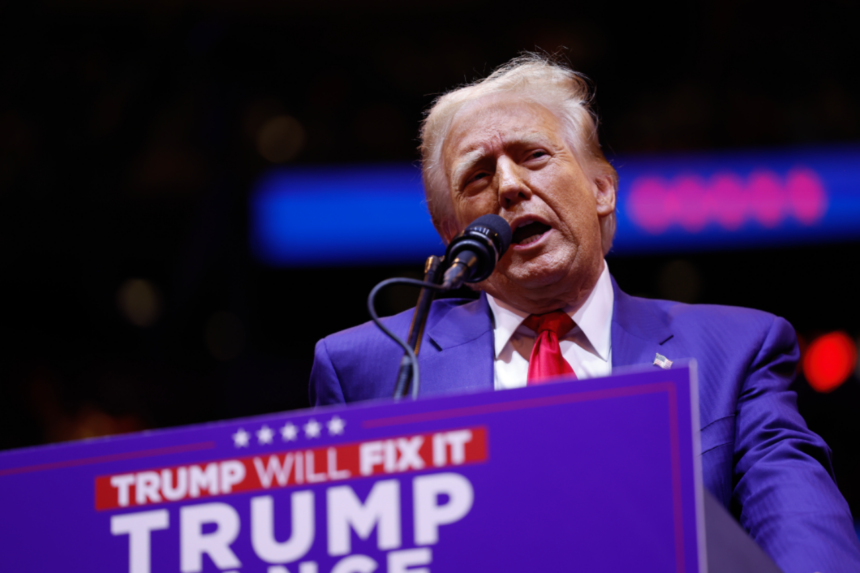Donald Trump has proclaimed himself a champion for small businesses, with promises to cut regulations, slash taxes and encourage economic and business growth by slashing inflation and federal spending.
Trump’s tenure as president has been seen as a mixed bag by many, with current president Joe Biden rolling back several of the decisions and executive orders put in place by the Trump administration. Now, on the campaign trail, Trump has promised to return several of his administration’s old policies – with new ones in the roster.
If passed, will have a widespread impact on small businesses and their workers. Here are some of the key promises Trump has put forth, and how they’ll affect small businesses.
Eliminating tax on overtime
Both Trump and Kamala Harris have proposed eliminating taxes on tipped wages. Trump, however, has gone a step further and proposed eliminating taxes on overtime wages.
“The people who work overtime are among the hardest-working citizens in our country, and for too long, no one in Washington has been looking out for them,” Trump said at an Arizona rally in September 2024. “Those are the people that really work. They’re police officers, nurses, factory workers, construction workers, truck drivers and machine operators.”
Overtime is classified as hours worked over the standard 40-hour workweek for hourly-paid full-time workers, requiring a minimum of time-and-a-half pay for each hour worked.
For businesses, exempting overtime from taxes could make recruiting hourly paid workers easier, as overtime pay could potentially present more take-home pay than an equivalent salaried position. It could also bring more money into the economy, giving hourly workers more money to spend and stimulating businesses.
However, the policy would also face several legislative hurdles due to the impact on federal revenue, says Bankrate’s senior economic analyst Mark Hamrick.
“It could help smaller businesses retain and attract certain workers,” Hamrick added. “It would be negative, however, if workers and businesses felt compelled to work more or longer hours when many might already feel overworked.”
- Hourly workers could increase their take-home pay, giving them more money to spend.
- Businesses could have an easier time recruiting hourly workers.
- Workers could feel more satisfaction with more take-home pay.

Cons
- The policy may not pass due to legislative hurdles.
- Federal revenue would be decreased.
- Workers may feel pressured to work more overtime.
Eliminating federal income tax
Trump has entertained the idea of using tariffs to completely replace federal income tax entirely, which he argues will put more money back in Americans’ pockets and reduce pressure for those unable to pay their taxes.
Higher take-home pay could put less wage pressure on businesses, and increase economic activity as consumers have more money to spend.
Economists and law experts, however, have warned that not only will eliminating the federal income tax face heavy resistance from legislature reluctant to change the tax code, but force the government to raise taxes and fees elsewhere in order to maintain federal revenue.
This may in turn increase the price of products and services on top of the tariff-increased prices on foreign goods, putting additional pressure on businesses to raise their prices and possibly increasing operating costs.

Pros
- More consumer spending power.
- Lower pressure to increase wages.
- Easier tax preparation for business owners and independent contractors.

Cons
- Possibly raised taxes and fees in other categories.
- The policy would be difficult to pass through Congress.
- Prices could increase due to tariffs and other taxes.
Cutting Biden-era regulations
Trump has made cutting regulations a regular talking point on the campaign, promising to cut everything from environmental to worker classification regulations set in place by the administration of president Joe Biden.
In a September 2024 speech at the Economic Club of New York, Trump stated he would cut regulatory spending at an exponential rate with the aim of ushering in efficiency and cutting regulatory costs and fees for businesses.
“I will launch a historic campaign to liberate our economy from crippling regulation,” Trump said. “Over the past four years, Kamala has added $6,300 a year in regulatory costs onto the backs of the typical American family. Think of that. To stop this onslaught at lower prices, I’m pledging today that in my second term, we will eliminate a minimum of 10 old regulations for every one new regulation.”
While Trump has not made it clear which regulations he will cut, many Biden-era regulations have impacted businesses and workers, including requirements for staffing at long-term care facilities, bans on noncompete clauses, updates to the minimum wage policy that increase the requirements for overtime pay exemptions, regulations to further tighten the standards that classify gig economy and contract workers, and several sets of rules tightening emissions and pollution restrictions.
While some have called these regulations to be overly cumbersome, experts argue that these rules serve an important role in protecting workers’ rights, helping lift up small businesses and helping to prevent ongoing issues such as pollution and climate change.

Pros
- Businesses could have fewer regulations to navigate when operating.
- Small businesses could pay less in regulatory fees.
- Business law could become easier to navigate for entrepreneurs.

Cons
- Certain workers could lose their Biden-era protections.
- Issues that the Biden administration wanted to address, such as climate change, could face regression.
- Cutting regulations could face long-term legislative pushback.
Tax cuts for American-employed businesses
Trump has also promised to cut the corporate tax rate from 21 percent to 15 percent, with strings attached:
“You have to make your product in America,” Trump said at the Economic Club speech. “If you outsource, offshore, or replace American workers, you’re not eligible for any of these benefits.”
Trump’s intention is to pull more American workers into the workforce, claiming it will strengthen the economy, put more money in Americans’ pockets and discourage businesses from undercutting the wage market by offshoring or bringing in laborers willing to work for lower pay.
However, the policy could have drawbacks. Businesses that rely on immigrant or overseas labor would have a heavier tax burden, and it could incentivize the wrong objective for American businesses, Hamrick says.
“One of the great historical strengths of the U.S. economy has been diversity and immigration, which help satisfy demand for labor and talent,” Hamrick says. “If businesses are restricted from finding the workers they want and need, that will be an impediment to success.”

Pros
- Businesses could be incentivized to employ more American workers.
- Workers could see a better wage market with a reduced labor pool.
- Americans could have more of a chance for workforce participation.

Cons
- Businesses could be incentivized to cut out a major part of their workforce.
- With a smaller labor pool, businesses would have a harder time recruiting people.
- Businesses would lose out on a source of diversity.
Bottom line
With just a few days until the Election, both the Trump and Harris campaigns are working on their final pushes to undecided voters. Like many of Trump’s plans for the economy, doubts remain over the feasibility of these plans and if they’d even be helpful to small businesses. Regardless of who wins, it remains to be seen how many promises of either candidate will come to fruition after Inauguration Day.











